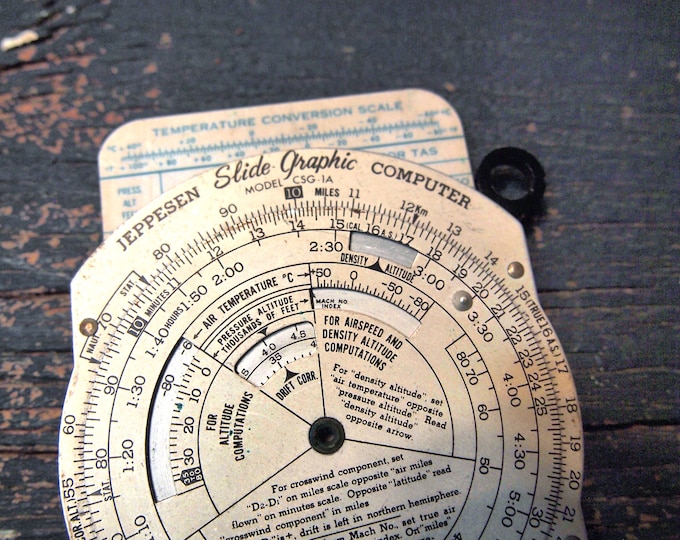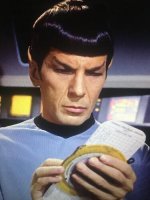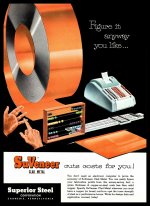I own a small collection of slide rules.
I've actually got two of the Flying Fish ones. They're rather unique:


... but what I actually used in EE undergrad, was an HP-45 (2nd generation, LED display) calculator. I bought it for $295 from my wages as a $2.10/hour busboy at Trader Vics during high school. Years later I worked at the semiconductor company who made the chips inside that calculator. Small world.
Pickett 160ES -- "student slide rule", yellow plastic rule + black leather holster, 6 inch
Pickett N803ES -- yellow metal rule + black leather holster, 12 inch
Keuffel & Esser Log Log Decitrig -- wood rule with ivory scales + orange leather holster, 12 inch
Faber Castell 12/82 Log Log Decitrig -- plastic rule + green plastic case, made in Germany
Flying Fish Type 1002 Vectoral Natural Log -- plastic rule + grey plastic case, made in Shanghai, China (new in box)
K&E Slide Rules: A Self Instruction Manual -- hardcover book (link)
I've actually got two of the Flying Fish ones. They're rather unique:


... but what I actually used in EE undergrad, was an HP-45 (2nd generation, LED display) calculator. I bought it for $295 from my wages as a $2.10/hour busboy at Trader Vics during high school. Years later I worked at the semiconductor company who made the chips inside that calculator. Small world.
Last edited:
I still have mine, works after 48 years.... paid $400 CDN in '74, .... equal to 5 months student room & board. RPN and polar / rectangular were perfect for EE. Mostek Chips, right?what I actually used in EE undergrad, was an HP-45 (2nd generation, LED display) calculator.
I used the Sun Hemmi No. 255. It was advertised in the Hemmi catalogues as being for Electrical Engineering. It has conversion of angle, hyperbolic function and vector scales. My brother was working in Yokosuka, Japan at the time and sent it to me. The cost was 3000 yen. I showed it to a professor and he said if the professor in transmission lines sees it he will think you are cheating. I had to get special permission to leave some answers in radians but I was correct. All the other students were basically using civil engineering slide rules. There's one in the Smithsonian I don't know if it has the instruction book or not. MIne is in perfect condition.

To me it's easier to ....Of course it's the same equation, just rearranged
The parallel resistor 'stick trick' provoked discussion:
As of slide ruler use, way back then they were so associated with Engineering use, that Isaac Asimov who imagined a HEAVY advance in computer power and miniaturization, so much as to allow very complex "almost Human" Robots with, of course, Electronic brains (ok, "Positronic" 😉 ) , yet his "Space flight Engineers/Navigators" used slide rules to calculate ship trajectories, including Hyperspace jumps, go figure.
"Space flight Engineers/Navigators" used slide rules to calculate ship trajectories
See attachments for both fact and fiction! 😎
Attachments
I have a few slide rules and can rarely pass one up if the price is right. A really fascinating circular slide rule is built into the General Radio Corp. 1559-B Microphone Reciprocity Calibrator. There's a floating dial that is locked in position by a brake, or is allowed to couple to another dial, depending on a switch position. After a sequence of measurements, where the dial alternately follows and doesn't follow, the final microphone sensitivity can be read directly on the larger dial. IMHO, it's a simple affair, but it took a really clever mind to come up with it. His name was Basil A. Bonk and they were able to patent the device.

Giant electric slide rule. Around 5:30 in the video. This guy also has made thousands of glass Klein bottles, he's aa little eccentric...
Thanks 🙂See attachments for both fact and fiction! 😎
Aldrin is using a conventional one, but Mr Spock is using a highly specialized Jeppesen Flight Computer.
Obviously the Interstellar Space Flight version 🙂



FWIW my Brother is a Commercial Pilot, and still swears by his.
There is a digital version, of course, but has the same inherent problem as all "simulators": you can punch nonsense into it and it will proudly display "some numbers" which if taken at face value can lead to BAD problems; while the "all the data in front of you" graphic type quickly makes you think "WTF? ... this can´t be right!!!"
https://www.sliderulemuseum.com/Soviet.htm

Circular slide rule calculator.
Among one of many there...
Circular slide rule calculator.
Among one of many there...
My brother is a decade older than I am, and he used a slide-rule in engineering college. I remember that one of the special features of his slide-rule was a small built in abacus on the back, recessed into the body, made of sliding strips of metal with numbers on them, rather than beads on a wire. To do calculations, you could slide the strips up and down using the blunt tip of a pencil, ball-point pen, or anything similar.
I only ever figured out how to do addition and subtraction with the abacus (experts can do much more), but that was already a very nice complement to the slide-rule's ability to do multiplication and division.
If faded memory still serves, my brother's slide-rule also had scales calibrated to find directly find squares and square-roots, without having to halve or double logarithms mentally. I think there was also a scale that let you multiply by pi (3.142) directly, something very common in physics and engineering.
-Gnobuddy
I only ever figured out how to do addition and subtraction with the abacus (experts can do much more), but that was already a very nice complement to the slide-rule's ability to do multiplication and division.
If faded memory still serves, my brother's slide-rule also had scales calibrated to find directly find squares and square-roots, without having to halve or double logarithms mentally. I think there was also a scale that let you multiply by pi (3.142) directly, something very common in physics and engineering.
-Gnobuddy
Kid, you were born too late.had scales calibrated to find directly find squares and square-roots, without having to halve or double logarithms mentally. I think there was also a scale that let you multiply by pi (3.142) directly, something very common in physics and engineering.
Square & square-root are trivial. Find number on A scale with cursor, read on D scale. Or vice-versa for root. Or on C and B scales if that's where you are (there are usually several ways to skin a cat).
You see the D/C scales repeat 1..10 twice. The K scale repeats 1..10 thrice; yes, the Kube.
Good engineer's rules will have pi, maybe 2pi and 4pi, marked on scale. My Diezgen's DF and CF scales start on pi so there's that.
http://www.sliderules.info/a-to-z/squares.htm
http://www.sliderules.info/a-to-z/scales.htm
http://www.sliderules.info/a-to-z/oldbasics.htm
http://www.sliderules.info/pdf/pdf.htm
Someone should capture that site: it is (despite the .info) very old and may rot.
Attachments
Just seen online:
"...a {computer} mouse that weighs just 0.15 lb ± 0.01 ounce (69 g ± 2.5 g)."
https://arstechnica.com/gadgets/202...-lets-you-pick-the-shape-of-its-side-buttons/
As an ex-sliderule user (also ex-dopeuser) the errors were obvious to me right away.
(Aside from the unit absurdity of pound +/- ounce.)
FYI: 16 ounces to the pound, 28.3495 grams to the ounce.
There's a slipped decimal point (sliderulers track that in the bottom of the mind) and 13% and 1.4% rounding flaws.
"...a {computer} mouse that weighs just 0.15 lb ± 0.01 ounce (69 g ± 2.5 g)."
https://arstechnica.com/gadgets/202...-lets-you-pick-the-shape-of-its-side-buttons/
As an ex-sliderule user (also ex-dopeuser) the errors were obvious to me right away.
(Aside from the unit absurdity of pound +/- ounce.)
FYI: 16 ounces to the pound, 28.3495 grams to the ounce.
There's a slipped decimal point (sliderulers track that in the bottom of the mind) and 13% and 1.4% rounding flaws.
Ahh! But they do ... it's just that the scales are logarithmic ...Slide rules just do not add up! 😉
Very interesting, PRR.Using The Slide Rule In Electronic Technology
View attachment 1039636
https://www.sliderulemuseum.com/Man...uleInElectronicTechnology_ECharlesAlvarez.pdf
24MB PDF
I bought my slide rule in the penultimate year that my old school bought them in bulk.
Shortly after got Commodore programmable thingy which sadly no longer works - after 25 years though - but my slide rule still does.
Ahh! But they do ... it's just that the scales are logarithmic ...
I'm moved to repeat my post #24, John. 😉
My little joke referred to the arithmetic operation of addition.
And, of course, a slide rule performs multiplication according to the principle of adding logs.
- Home
- General Interest
- Everything Else
- Using The Slide Rule In Electronic Technology


